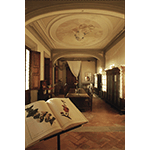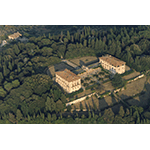Polo Museale di Villa Caruso Bellosguardo [Museum Complex of Villa Caruso Bellosguardo]
The birth of Villa Bellosguardo was the result of the efforts of abbot Alessandro Pucci who, between 1585 and 1595, transformed a pre-existing manor house, assisted by several of the most famous architects and artists of the time: Giovanni Antonio Dosio was entrusted with the project of the villa, Niccolò Pericoli, known as "Tribolo" attended to laying out the garden, painters Naldini and Calducci painted the fresco cycle on the walls of the building.
In the course of time, the villa and park underwent numerous transformations until the 20th century when they became property of famous Neapolitan tenor Enrico Caruso who enlarged the wing dedicated to the farm, and imposed a more scenographic layout on the garden, giving the complex its definitive layout.
At one time, the facade of the building was completely frescoed. Today it houses a museum divided into four sections: the villa and its interior, the garden and park areas, the Amateur Botanical Library and the Farming Museum, all with a careful and thorough system of signs.
Conceived along the criteria of an Italian garden, the parterre hosts numerous tree species and potted lemon trees. With the park and its abundance of autochthonous plants (pine trees, turkey oaks, cypress trees, and holm-oak trees) and valuable sculptural groups, it forms an interesting itinerary of historical-botanical interest, which finds its natural complement in the Amateur Library, housed in the noble chapel that looks out onto the garden. The Library indeed contains works of ancient literature, herbaria, botanical illustrations, both antique (from the 17th century to the 19th century) and modern, officinal texts and narrative literature on related subjects, that can be consulted in the reading room.
No less interesting from the technical point of view is the "Lazzeri Collection", an assemblage of objects tied to farming activity, including still-functioning machines for pressing oil and bottling wine. The cross section of farming life is completed by a section devoted to domestic animals which, in the enclosures on the edge of the woods, hosts many typical Tuscan races, today endangered by the competition with foreign species.
Villa Caruso is today the headquarters of the association with the same name that since 1996 has purposed, through publications, training courses and conventions, to promote research in art and culture, with particular attention to the field of music and opera.
****************************
Texts by Elena Fani
English translation by Victor Beard
Last update 09/feb/2008





